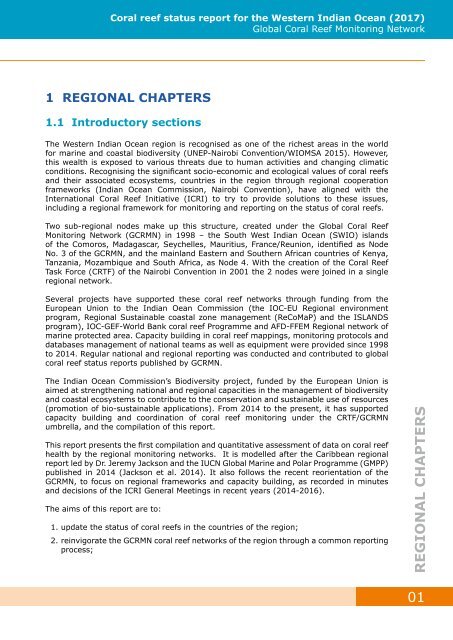GCRMN_COI_2017-Western Indian Ocean Reef Status
GCRMN Western Indian Ocean Coral Reef Status report for 2017. Produced by the Indian Ocean Commission and CORDIO East Africa
GCRMN Western Indian Ocean Coral Reef Status report for 2017. Produced by the Indian Ocean Commission and CORDIO East Africa
Create successful ePaper yourself
Turn your PDF publications into a flip-book with our unique Google optimized e-Paper software.
Coral reef status report for the <strong>Western</strong> <strong>Indian</strong> <strong>Ocean</strong> (<strong>2017</strong>)<br />
Global Coral <strong>Reef</strong> Monitoring Network<br />
1 REGIONAL CHAPTERS<br />
1.1 Introductory sections<br />
The <strong>Western</strong> <strong>Indian</strong> <strong>Ocean</strong> region is recognised as one of the richest areas in the world<br />
for marine and coastal biodiversity (UNEP-Nairobi Convention/WIOMSA 2015). However,<br />
this wealth is exposed to various threats due to human activities and changing climatic<br />
conditions. Recognising the significant socio-economic and ecological values of coral reefs<br />
and their associated ecosystems, countries in the region through regional cooperation<br />
frameworks (<strong>Indian</strong> <strong>Ocean</strong> Commission, Nairobi Convention), have aligned with the<br />
International Coral <strong>Reef</strong> Initiative (ICRI) to try to provide solutions to these issues,<br />
including a regional framework for monitoring and reporting on the status of coral reefs.<br />
Two sub-regional nodes make up this structure, created under the Global Coral <strong>Reef</strong><br />
Monitoring Network (<strong>GCRMN</strong>) in 1998 – the South West <strong>Indian</strong> <strong>Ocean</strong> (SWIO) islands<br />
of the Comoros, Madagascar, Seychelles, Mauritius, France/Reunion, identified as Node<br />
No. 3 of the <strong>GCRMN</strong>, and the mainland Eastern and Southern African countries of Kenya,<br />
Tanzania, Mozambique and South Africa, as Node 4. With the creation of the Coral <strong>Reef</strong><br />
Task Force (CRTF) of the Nairobi Convention in 2001 the 2 nodes were joined in a single<br />
regional network.<br />
Several projects have supported these coral reef networks through funding from the<br />
European Union to the <strong>Indian</strong> Oean Commission (the IOC-EU Regional environment<br />
program, Regional Sustainable coastal zone management (ReCoMaP) and the ISLANDS<br />
program), IOC-GEF-World Bank coral reef Programme and AFD-FFEM Regional network of<br />
marine protected area. Capacity building in coral reef mappings, monitoring protocols and<br />
databases management of national teams as well as equipment were provided since 1998<br />
to 2014. Regular national and regional reporting was conducted and contributed to global<br />
coral reef status reports published by <strong>GCRMN</strong>.<br />
The <strong>Indian</strong> <strong>Ocean</strong> Commission’s Biodiversity project, funded by the European Union is<br />
aimed at strengthening national and regional capacities in the management of biodiversity<br />
and coastal ecosystems to contribute to the conservation and sustainable use of resources<br />
(promotion of bio-sustainable applications). From 2014 to the present, it has supported<br />
capacity building and coordination of coral reef monitoring under the CRTF/<strong>GCRMN</strong><br />
umbrella, and the compilation of this report.<br />
This report presents the first compilation and quantitative assessment of data on coral reef<br />
health by the regional monitoring networks. It is modelled after the Caribbean regional<br />
report led by Dr. Jeremy Jackson and the IUCN Global Marine and Polar Programme (GMPP)<br />
published in 2014 (Jackson et al. 2014). It also follows the recent reorientation of the<br />
<strong>GCRMN</strong>, to focus on regional frameworks and capacity building, as recorded in minutes<br />
and decisions of the ICRI General Meetings in recent years (2014-2016).<br />
The aims of this report are to:<br />
1. update the status of coral reefs in the countries of the region;<br />
2. reinvigorate the <strong>GCRMN</strong> coral reef networks of the region through a common reporting<br />
process;<br />
REGIONAL CHAPTERS<br />
01


















